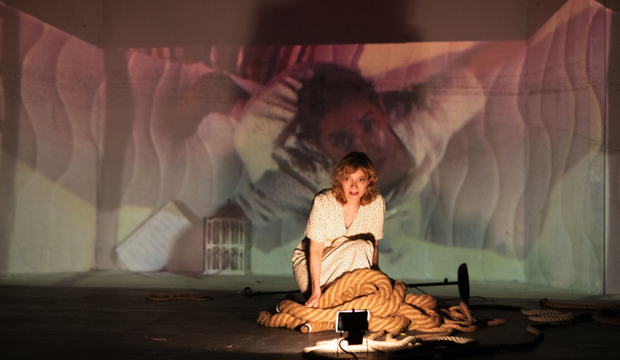The Yellow Wallpaper review ★★★★★
The Yellow Wallpaper at the Coronet Theatre is a genre-fusing adaptation of an early feminist novella about mental health and female oppression
The Yellow Wallpaper, Aurelia Thiérrée, Fukiko Takase. Photo: Hugo Glendinning
The American novelist and early feminist Charlotte Perkins Gilman (1860–1935) is perhaps best remembered for her semi-autobiographical novella The Yellow Wallpaper. In it she tells the story of a young woman incarcerated in an attic nursery by her husband as a cure for 'a slightly hysterical tendency’, who becomes obsessed with the room's yellow wallpaper.
In this staging, meticulously directed by Stephanie Mohr, Aurelia Thiérrée, offspring of the Illustrious Chaplin and Thiérrée performing clans, enacts the first-person tale, while live images of dancer and choreographer Fukiko Takase dancing in the smaller Coronet studio are projected on a skewed screen behind her.
The increasingly claustrophobic set is littered with what appear to be the detritus from past lives: a shrouded pram, an old mattress, thick ropes snaking across the floor, clothes hanging from the rafters. Here the unnamed woman, to whom Thiérrée imparts an affecting fragility, is confined by her physician husband, John, never seen but often quoted.

The Yellow Wallpaper, Aurelia Thiérrée and Fukiko Takase. Photo: Hugo Glendinning
The text is fascinating: on the surface the woman meekly defers to her husband’s conviction that confinement is the only way to cure what soon becomes clear is a case of post-natal depression. 'What is one to do?' she asks with a shrug of resignation.
In the distance a baby’s wail is heard.
Yet, underneath those words there is the clear sense that deep inside she knows he’s a wrongheaded bully, if only she would allow herself to admit it. She tells us what she thinks would make her better: to meet people, to be allowed to walk in the countryside… but John won't hear of it. 'What is one to do?' she asks again. And again.
On the screen the dancer moves around a huge bed. Sometimes she’s playful, jumping on the soft mattress; at other times she collapses in a gesture of despair. Sometimes her movement tallies with the words; at others she is like a ghost of women past enacting their own memories.
With her mental health deteriorating, the woman fixates on the yellow wallpaper, like her husband never seen, but obsessively referred to. The wallpaper is fungus-stained, its colour horrendous, its smell all-pervasive. In what she perceives as its shifting shape, she imagines a trapped woman, whom she must absolutely liberate.
As the play approaches its climax the ever more frantic woman tears the paper off the wall. The dancer emerges from the screen. The woman finds freedom in madness.
At just one hour's duration this production of The Yellow Wallpaper packs a powerful punch, its questions about mental health and female oppression still poignant and relevant. Thiérrée's acting is compelling, Takase's dancing adding a hallucinatory dimension to her words. And plaudits, too, to Mike Winship subtle but tremendously atmospheric sound design.
In this staging, meticulously directed by Stephanie Mohr, Aurelia Thiérrée, offspring of the Illustrious Chaplin and Thiérrée performing clans, enacts the first-person tale, while live images of dancer and choreographer Fukiko Takase dancing in the smaller Coronet studio are projected on a skewed screen behind her.
The increasingly claustrophobic set is littered with what appear to be the detritus from past lives: a shrouded pram, an old mattress, thick ropes snaking across the floor, clothes hanging from the rafters. Here the unnamed woman, to whom Thiérrée imparts an affecting fragility, is confined by her physician husband, John, never seen but often quoted.

The Yellow Wallpaper, Aurelia Thiérrée and Fukiko Takase. Photo: Hugo Glendinning
The text is fascinating: on the surface the woman meekly defers to her husband’s conviction that confinement is the only way to cure what soon becomes clear is a case of post-natal depression. 'What is one to do?' she asks with a shrug of resignation.
In the distance a baby’s wail is heard.
Yet, underneath those words there is the clear sense that deep inside she knows he’s a wrongheaded bully, if only she would allow herself to admit it. She tells us what she thinks would make her better: to meet people, to be allowed to walk in the countryside… but John won't hear of it. 'What is one to do?' she asks again. And again.
On the screen the dancer moves around a huge bed. Sometimes she’s playful, jumping on the soft mattress; at other times she collapses in a gesture of despair. Sometimes her movement tallies with the words; at others she is like a ghost of women past enacting their own memories.
With her mental health deteriorating, the woman fixates on the yellow wallpaper, like her husband never seen, but obsessively referred to. The wallpaper is fungus-stained, its colour horrendous, its smell all-pervasive. In what she perceives as its shifting shape, she imagines a trapped woman, whom she must absolutely liberate.
As the play approaches its climax the ever more frantic woman tears the paper off the wall. The dancer emerges from the screen. The woman finds freedom in madness.
At just one hour's duration this production of The Yellow Wallpaper packs a powerful punch, its questions about mental health and female oppression still poignant and relevant. Thiérrée's acting is compelling, Takase's dancing adding a hallucinatory dimension to her words. And plaudits, too, to Mike Winship subtle but tremendously atmospheric sound design.
TRY CULTURE WHISPER
Receive free tickets & insider tips to unlock the best of London — direct to your inbox
| What | The Yellow Wallpaper review |
| Where | The Coronet Theatre, Print Room, 103 Notting Hill Gate, London, W11 3LB | MAP |
| Nearest tube | Notting Hill Gate (underground) |
| When |
21 Sep 23 – 07 Oct 23, 19:30 Dur.: 90 mins no interval |
| Price | £20-£40 (20% off previews) |
| Website | Click here to book |